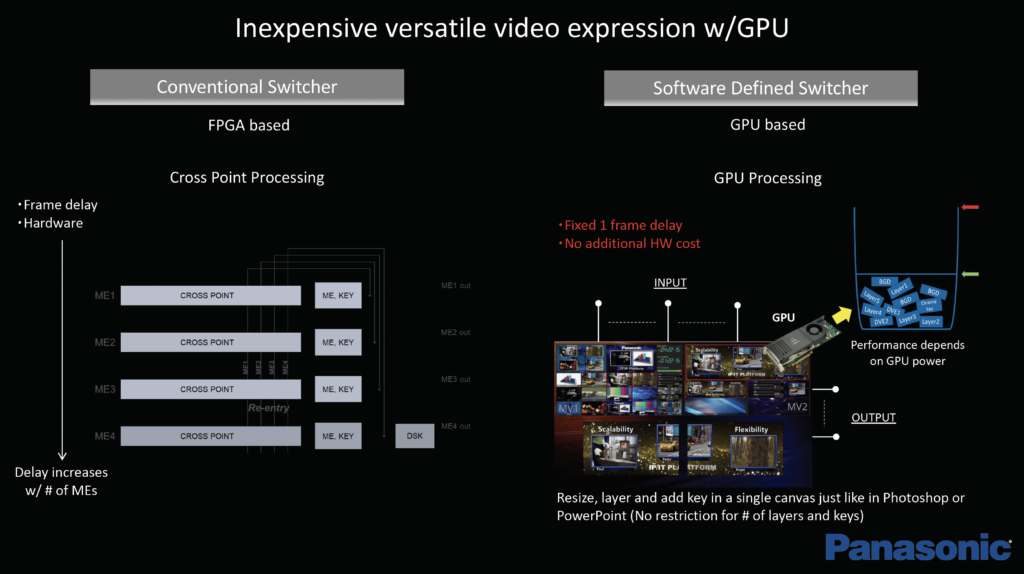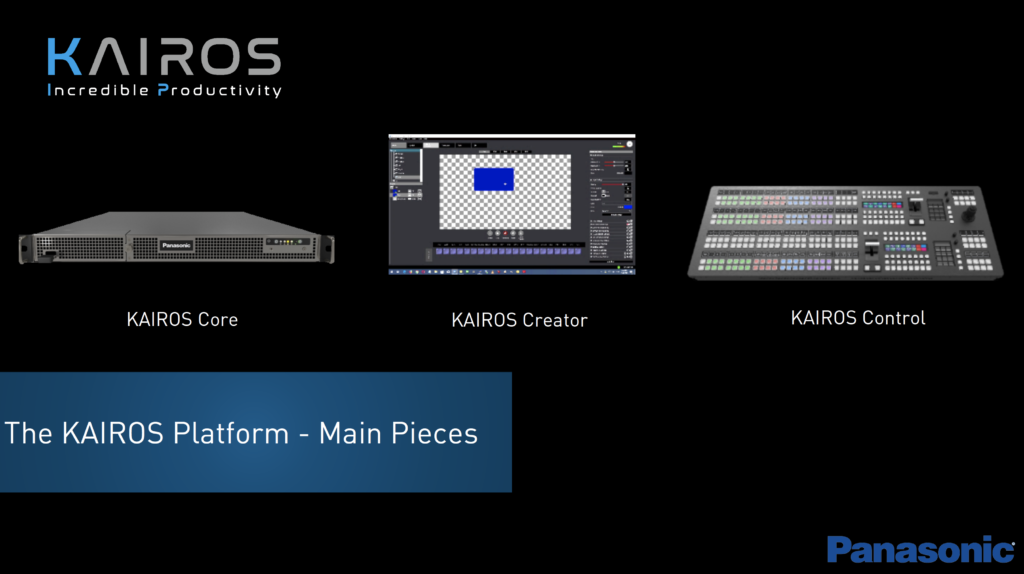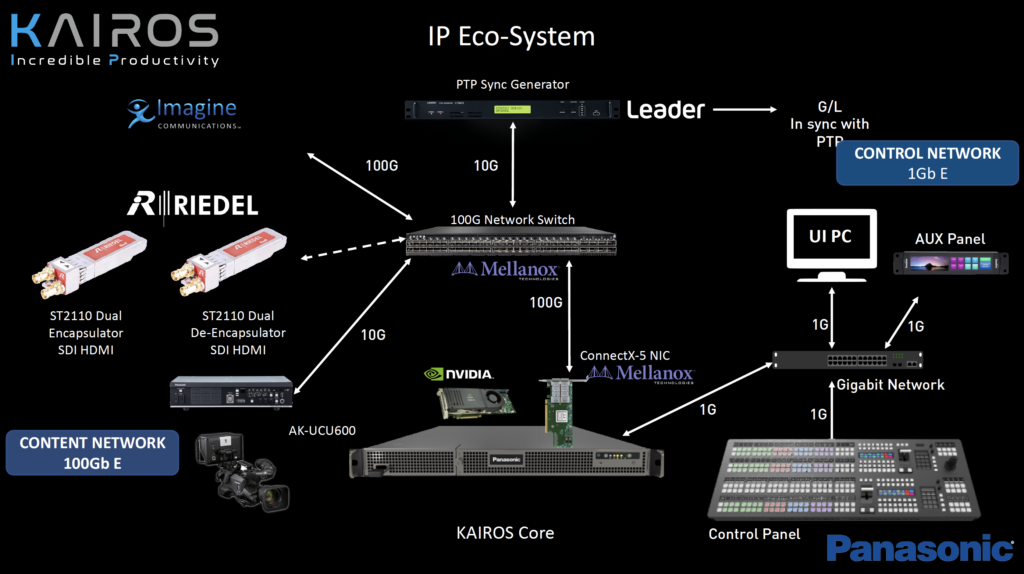September 17, 2020
7 min read
KAIROS is our IT/IP platform that gives you unlimited control by fully utilizing the power and flexibility of its CPU and GPU, offering unrestricted flexibility of input, output and operation for a more efficient live workflow. We caught up with Panasonic Engineering Manager Harry Patel to talk all things KAIROS, including its origins, the state of SMPTE 2110, KAIROS’ configuration and components and how it can be the “Photoshop” for video.
QUESTION: What is KAIROS and how is it different from a traditional switcher?
HARRY PATEL: Overall, the way I like to think about KAIROS is in two different components. The first is in IT/IP input/output source management. By using high-speed Ethernet networks utilizing SMPTE 2110 protocols, we’re able to bring in any source that is on a network, potentially replacing a need for a router that will typically be there. That’s because any ST 2110 stream has multi-casting enabled by default so you can send one input to as many outputs as you like. That is really powerful.
The second component to KAIROS is utilizing CPU/GPU-based processing for video switching and video processing, giving the user complete flexibility on how they want to use the product compared to traditional FPGA-based hardware. You have predefined the use case of what an M/E is and how many keyers it has, but when it comes to a switcher application the resources cannot be dynamically changed to do something else. With KAIROS, due to CPU/GPU-based technology and the evolution in the technology, we are able to change the horsepower of the system for a user who may not need a lot of M/Es and needs to have multiple outputs, versus a user that needs so many layers and multi-viewers. So for CPU/GPU based technology, it's quite flexible compared to FPGA systems where you are completely locked in.

KAIROS flexibility versus traditional FPGA systems
QUESTION: What is the origin of KAIROS and what went into the development of the system?
PATEL: Panasonic has been in the switcher business for many years and we were also active in developing the SMPTE 2110 protocol for the broadcast industry. This basically allowed video over IP transmission and solved scalability and flexibility issues that traditional switchers can’t offer. We also saw the advancements in CPU/GPU based technologies that could be applied to broadcast or live event production. The word KAIROS means that the you've been contemplating on doing something over and over again. The moment you decide you have the clarity on doing something, that is the KAIROS moment.
QUESTION: You mentioned SMPTE 2110. Has the standard been widely adopted in the industry?
PATEL: SMPTE 2110 as an IP standard is currently being utilized by several larger broadcast stations for flexibility and scalability. For large scale live productions, there are often too many inputs and outputs that traditional routers cannot handle. We see an opportunity where ST 2110 can move down the stream and be applied into products like studio cameras or live production switchers where connectivity between the devices could be 100% IP. Overall, ST 2110 is commonly accepted in the broadcast space right now but we also see an opportunity where we can use it on mid-tier applications. This would be not only for broadcast applications, but for live events like Houses of Worship and corporate A/V.
Watch KAIROS - More Than a Switcher
KAIROS - More Than a Switcher from Panasonic on Vimeo.
In addition, you’re also managing your iMAG, remote feeds and more. To be able to manage all of your displays, regardless of the resolution, you want to have a single platform. Ultimately, the single platform is benefiting in your total aggregated latency from camera to display. Having one platform processing all your outputs and sharing all your sources that are available on the network makes it a very streamlined production. And you do not have to worry about latencies that are aggregated because of multiple devices that you may have to put into the pipe to run that workflow. So with this platform, you can now process your non-standard resolution LED boards, iMAG and remote feed – all from a single platform.
QUESTION: What sort of bandwidth do you need for a KAIROS live production in HD? For 4K
PATEL: Typical network switches that are utilized in this scenario are high-speed network switches and the connectivity that you provide between the network switch and the server is 100Gbs. For a typical 3G signal, you need roughly about 3Gbs of bandwidth. For 4K, that is four times larger so roughly 12Gbs of bandwidth is needed. Also, it’s important to know that there is no compression in processing the IP video stream, so ST 2110 is natively uncompressed. In terms of 4K HDR, bringing that video stream into the KAIROS switcher is currently within that 100Gb pipe that’s going to the switcher.
If I'm a switcher operator who wants to run a show in 3G, I can bring in 32 inputs, which is no problem within that 100Gb pipe. When I go 4K, that's now divided by four, so I can only bring in eight 4K signals. Now, it is true also that these are concurrent signals. So let's say on the network switch, you could have a hundred inputs. And from those hundred inputs, you can choose either 32-3g or 8-4K. (16-3G & 4-4K can come into the switcher at the same time.) Also, you're not locked into those 32 inputs and you can change between them. That 100Gb pipe is currently what we have available. Eventually on the PCI bus, when that grows to let's say, 200Gb or 400Gb, our ability to accept more inputs would also grow.
Watch KAIROS Cover An Esports Event
QUESTION: KAIROS has been described as sort of a Photoshop for video production. What is the comparison?
PATEL: The user interface of KAIROS has been designed for the operator with minimal experience who wants to do a small show, as well as the experienced operator who wants to do a large show. The UI can adapt to both. It is layer based processing system so that you don't necessarily have to think about where you’re going to get the resource to do something. If you want to add a Picture-in-Picture, you don't have to worry about which keyer you are going to use. That is really the power of CPU/GPU based live production switcher, which allows you to not worry about what resource you're going to use for that particular effect, or how you're going to manage your effects. The user interface makes it extremely easy for you to track all your processing and allows a tremendous amount of flexibility in terms of composing your scenes.
QUESTION: What does KAIROS look like in terms of the configuration, and what components are available?
PATEL: First, you have the KAIROS Core (AT-KC100), which is the actual processing core. Accompanied with that is the user interface called the KAIROS Creator (AT-SFC10). KAIROS Control (AT-KC10C1) is the control panel that is a physical hard panel – a two M/E style control panel that gives you control at your fingertips.

KAIROS components include KAIROS Core, Creator and Control
Within the ecosystem, you have the KAIROS Core at the center, which is connected to the network switch, and the network switch has the IP inputs. For any of those traditional users who do not have IP outputs, they can use gateways, which are available from providers like Riedel or Imagine who can take an SDI source and convert it to IP and make it available on the network switch. For those who may not want to follow the IP path, there are modules available from Deltacast, which will allow you to take an SDI and make it available directly to the server bypassing the network switch. For a user who doesn't need the flexibility of IP and wants to have the flexibility of the user experience and the software defined video switching, they can still utilize Deltacast modules to bring sources in and out. Going back to the IP side, to synchronize all the video sources that are coming in, you need a PTP (Precision Time Protocol) clock, which is a mandatory sync signal to work in ST 2110 networking (slide 21:33).
Many switchers are adapting to ST 2110 but KAIROS is doing it differently. Many switchers accept ST 2110 as an input, but in reality they are accepting an SDI input and then pushing it to an FPGA based core. We are taking an IP input natively and sending it to a CPU/GPU based platform. Our approach is completely flexible and scalable.

KAIROS ecosystem with the Core as the hub.
QUESTION: In our current situation with the pandemic, is KAIROS a good solution for remote production?
PATEL: In today’s environment, a TD might not be there in person to operate a show, but with KAIROS the TD can have the UI and control panel at home while the Core can be at the venue where it can be controlled remotely. From the remote production side, KAIROS still accepts uncompressed signals meaning you would have to figure out a way of getting your remote locations connected. You would need to use technology like SRT (Secure Reliable Transport). An example would be a camera with built-in SRT on the remote presenter. The cameras capturing the video sending it on the other side, you put an SRT decoder, convert that into an IP stream, or an SDI stream, and then bring it into KAIROS. So from the operation side of remote production, we have solved it but from the video side KAIROS is mainly an uncompressed video switcher. Hence, any compressed feeds would need to be handled externally.
QUESTION: Has KAIROS been used on any productions yet? What has the feedback been like?
PATEL: We ran the Panasonic ISE (Integrated Systems Europe) booth in Amsterdam with KAIROS and we were planning on running NAB 2020 with KAIROS before it got cancelled due to the pandemic. In terms of feedback, for the people who have seen or received demos, they really like the flexibility of the UI. It allows for them to operate it much easier. They can now be more focused on creative side of things, as well as the operation.
KAIROS is available now from your local reseller, including KAIROS hardware, software and third party hardware/software that is necessary to configure a system.
For more information, or if you would like to receive a demo, click through here.
![]()
